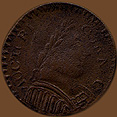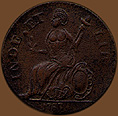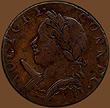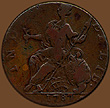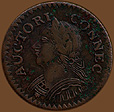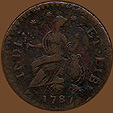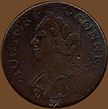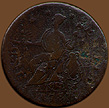Connecticut Coppers 1787
obverse |
|
reverse |
| |||
1787 Miller 1. 2 - C mailed bust right "Mutton Head" - Bailey counterfeit CT copper
Obverse: AUCTORI CONNEC
Reverse: INDE . ET LIB 1787
Weight: 124.3 g (8.05 grams) Diameter: 29.4 mm Reverse die alignment: 200°
Comments: Miller 1 is the only mailed bust right copper produced in 1787 (with the exception of the backdated Miller 52, of which only two specimens are known, see Breen item 787). The variety 1.2 can be distinguished because it has the largest head used during that year, known as the "Mutton Head" or "Bradford Head" variety (interestingly variety 1.1 has the smallest head). The initial A is very close to the shoulder while the final C is somewhat further away from the bust. This variety is a lightweight counterfeit that has been attributed to the mint of John Bailey in New York City. The thin but rather large size planchet was imperfectly annealed and is porous. This is a very nice example from an intermediate state of the die after regrinding. Apparently the regrinding was done to make the die shallower so the coins would appear to look worn from the time of minting. Notice in the legend that the right half of the first O, the left half of the second O, the final horizontal of each N as well as the entire final E have been ground off the die.
The reverse is easily distinguished as type C in that it is the only bare breast variety in the Connecticut series. It also has a very large stop after INDE and a single exergue line with a small sized date below. Also Liberty leans forward and holds a short branch with three leaves. This example is a good strike that has not been worn from circulation. The porosity of the planchet and the weak strike on the front were intentional to give this counterfeit coin a worn appearance and thus make it easier to put into circulation. Gary Trudgen has recently analyzed Nova Eborac coins for punch linkage and has discovered the 1787 Miller 1.2-C used some of the same punches, namely, the same numeral punches (1, 7 and 8) as were used on all of the Nova Eborac series and the same "E" punch as used on the medium head, figure right (Crosby 1-A) Nova Eborac copper (listed as the third of three E punches found in the Eborac series). See the Nova Eborac section for further information and bibliography.
Provenance: From the Robert H. Gore, Jr. Numismatic Collection.
obverse |
|
reverse |
| |||
1787 Miller 4 - L mailed bust left "Horned Bust" - Mould counterfeit CT Copper
Obverse: AUCTORI . CONNEC .
Reverse: IND[E .] ET. LIB . 1787
Weight: 108.0 g (7.00 grams) Diameter: 27.2 mm Reverse die alignment: 200°
Comments: The "Horned Bust" is easily distinguished because of the large die break at the shoulder of the figure. The present example is a very late state for the break is rather thick and long, extending from the mail to past the letter U. There is also a small die break, seen as a dot, behind the head. This is a lightweight counterfeit Connecticut copper attributed to Walter Mould at his mint in Morristown, New Jersey. The coin is usually found on a smaller planchet with a weight range of 105-115 grains as is the present example. A few examples survive on the larger size New Jersey planchets (29-31mm) with a weight range of 139-160 grains. At the bottom of the bust on the front center of the mail Mould included a star which is taken to be his mintmark. This mintmark can be seen on the following "Laughing Head" example but is frequently missing from the "Horned bust" variety. Apparently this is because the "Horned bust" die was made for the wider 29-31mm planchets but most coins were struck with the smaller Connecticut sized planchets as the 27.2mm example shown here. In order to get the full legend on the planchet the bottom of the bust was left off. Breen does illustrate a horned bust showing the star (Breen, item 768) but on that example the tops of the letters in the legend are cut off.
In addition to the die break the obverse can de distinguished by the large widely spaced letters in the legend with the first stop near the center of the I and the second stop near the lower part of the C. Early examples minted before the die break occurred can be easily identified for this the only mailed bust left of 1787 with a stop after but not before the words in the legend.
The reverse can be distinguished in that it is the only variety of the year with stops after each word but not before them. As on the obverse it has large widely spaced letters. Also the top leaf of the branch held by Liberty is just below the corner of the E (although on the present example that area is worn).
Provenance: From the Robert H. Gore, Jr. Numismatic Collection.
obverse |
|
reverse |
| |||
1787 Miller 6. 1 - M mailed bust left "First Laughing Head" - Mould counterfeit CT Copper
Obverse: . AUCTORI . . CONNEC .
Reverse: INDE : * * * ET . LIB : 1787
Weight: 116.0 g (7.52 grams) Diameter: 28.25 mm Reverse die alignment: 210°
Comments: This variety along with the previously discussed "Horned Bust" are lightweight counterfeit Connecticut coppers attributed to Walter Mould at his mint in Morristown, New Jersey. At the bottom of the bust on the front center of the mail near the denticles he included a six pointed star which is taken to be his mintmark. The mark is easily seen on this example. Miller 6 can be distinguished by the legend with stops before and after each of the words in the legend. Die 6.1, known as the "Laughing Head" can be distinguished by the distinctive nose and pursed mouth. It differs from the recut "Second Laughing Head" (die 6.2) in that the I in AUCTORI is over the hair and the stop is almost over the top leaf of the wreath (see 6.2 described below for further details).
The reverse has a distinctive punctuation with six pointed stars. Also the liberty cap is low on the pole, very close to the E in ET (a planchet void partly obscures this area on our example) and the date is distant from the single exergue line. This reverse was only combined with obverse dies 6.1 and 6.2.
Provenance: Purchased with the Robert H. Gore, Jr. Numismatic Endowment from Early American Numismatic Auctions, January 12, 1997 auction, lot 552.
obverse |
|
reverse |
| |||
1787 Miller 6. 2 - M mailed bust left "Second Laughing Head" - Mould counterfeit CT Copper
Obverse: . AUCTORI . . CONNEC .
Reverse: INDE : * * * ET . LIB : 1787
Weight: 98.1 g (6.36 grams) Diameter: 27.1 mm Reverse die alignment: 210°
Comments: Like the previous two examples this is a lightweight counterfeit Connecticut copper attributed to Walter Mould at his mint in Morristown, New Jersey. At the bottom of the bust on the front center of the mail he included a star which is taken to be his mintmark. This variety, which is a recutting of the obverse die of the "First Laughing Head" die is called the "Second Lasughing Head" or sometomes the "Smiling Head" or "Simple Head." It differs from the "First Laughing Head" in that the I in AUCTORI is over the forehead of the bust and the accompanying stop is very close to the letter I and quite distant from the top laurel leaf of the wreath. Also note there is a die break from the center of the mail down to the center of the star and the from the right edge of the star down to the rim. This example has a planchet void at the nose and another behind the bust. There are also some long scratches behind the bust, from the C down to the mail, as well as some corrosion.
The reverse has a distinctive punctuation with six pointed stars. Also the liberty cap is low on the pole and very close to the E in ET and the date is distant from the single exergue line. This reverse was only combined with dies 6.1 and 6.2. The example shown has some planchet voids most notably a wide but shallow void at Liberty's legs, there is also corrosion on the right side.
Provenance: From the Robert H. Gore, Jr. Numismatic Collection.
| Connecticut Coppers: 1786 | Section Contents | Connecticut Coppers: 1787, p. 2 |
|
For viewing tips and information on optimal computer settings click
here.
For questions or comments contact Special Collections by: |
